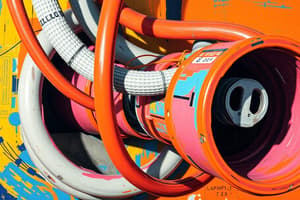Podcast
Questions and Answers
What is the purpose of a double-pole circuit breaker?
What is the purpose of a double-pole circuit breaker?
- To protect the entire circuit
- To provide 240 volts to a circuit (correct)
- To provide 120 volts to a circuit
- To distribute power throughout the home
Which type of tape is commonly used to insulate electrical wires?
Which type of tape is commonly used to insulate electrical wires?
- Duct tape
- Vinyl tape (correct)
- Aluminum tape
- Fiber tape
What is the function of GFCI outlets?
What is the function of GFCI outlets?
- To provide a stable electrical current
- To monitor the hot bus bars
- To protect against electrical shocks (correct)
- To distribute power throughout the home
Which type of screws are used to secure faceplates to switches and sockets?
Which type of screws are used to secure faceplates to switches and sockets?
What material is most commonly used to make electrical tapes?
What material is most commonly used to make electrical tapes?
How quickly can a GFCI outlet respond to abnormalities in the flow of electricity?
How quickly can a GFCI outlet respond to abnormalities in the flow of electricity?
What is the purpose of bushings in conduit fittings?
What is the purpose of bushings in conduit fittings?
When would you need special types of conduit fittings?
When would you need special types of conduit fittings?
What is the purpose of straps in conduit fittings?
What is the purpose of straps in conduit fittings?
What is the function of bends in conduit fittings?
What is the function of bends in conduit fittings?
Which type of fittings are commonly used to support conduit runs on fixed structures like beams or channels?
Which type of fittings are commonly used to support conduit runs on fixed structures like beams or channels?
In what scenario would you use locknuts in conduit fittings?
In what scenario would you use locknuts in conduit fittings?
Flashcards are hidden until you start studying
Study Notes
Electrical Components
- Couplings are available in various sizes, with some having internal threads, such as rigid conduit couplings.
- Electrical panels, also known as breaker panels, load centers, or service panels, are steel boxes that hold multiple circuit breakers wired to distribute power throughout a home.
Electrical Panel
- Circuit breakers snap into place onto one or both bus bars to provide power to circuits.
- Double-pole circuit breakers provide 240 volts to a circuit and snap into both hot bus bars.
- Electrical current leaves the service panel through hot wires connected to circuit breakers.
Electrical Tapes and Screws
- Electrical tape is a pressure-sensitive tape used to insulate electrical wires and conductive materials.
- Vinyl is the most popular material for electrical tape due to its flexibility and long-lasting insulation.
- Screws (switch box screws) secure faceplates to switches and sockets, and are useful when re-installing sockets during home improvement projects.
Circuit Breaker and GFCI Outlet
- GFCI circuit breakers protect the entire circuit, including wiring and devices connected to it, by installing one in the service panel.
- GFCI outlets constantly monitor electrical current on hot, neutral, and ground lines, and can physically turn off the circuit if an abnormality is detected.
- GFCI outlets can respond in 30 milliseconds or fewer, reducing the risk of injury from electrical shocks.
Conduit Fittings
-
Conduit fittings come in various sizes, shapes, and materials, and are used for connecting runs of conduit together, and to boxes, enclosures, or electrical devices.
-
Fittings are necessary for connecting conduits to boxes or enclosures of different sizes and for changing the direction of metallic conduits.
-
Special types of fittings are needed for conduits exposed to moisture, vapors, or hazardous conditions.
-
Conduit fittings include:
Bushing and Locknuts
- Bushings are installed on the inside of box openings and threaded into conduit ends, separating conductors from opening and conduit edges.
- Locknuts are threaded on the inside, with teeth on one surface or both, which grip the surface.
Straps and Clamps
- Straps are used to mount conduits to ceilings or walls using screws or bolts.
- Clamps are used to fasten conduit runs to fixed structures, like beams, hangers, or unistrut channels.
Bends
- Bends, also known as factory bends or elbows, are available in various lengths and curvatures.
Studying That Suits You
Use AI to generate personalized quizzes and flashcards to suit your learning preferences.




